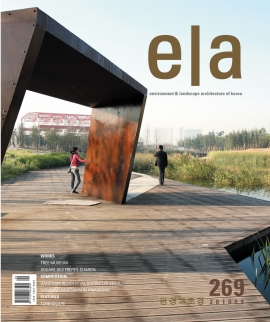Tianjin Qiaoyuan Wetland Park
2010 ASLA Professional Awards General Design 부문 Honor Awards 수상작
쓰레기 처리장으로 쓰이고 있던 방치된 사격장을 재생 설계와 지형 변화를 통해 식물 적응 및 식생군락 진화의 자연적 프로세스를 도입함으로써 유지관리가 손쉬운 도시공원으로 변모시켰다. 이 공원은 우수 집수 및 정화, 염성-알칼리성 토양 개선, 환경교육 기회제공과 소중한 미적 체험과 같은 다양한 자연 서비스를 제공한다.
중국 북쪽의 해안도시인 톈진에 위치한 치아오유안 습지공원은 22ha 규모이다. 급속한 도시화로 인해 교외의 사격장은 쓰레기 처리장이 되었고 도시의 우수 배수지가 되었다. 이 부지는 심각하게 오염되어 있었으며, 빈민가와 쓰러질 듯한 가건물들로 둘러싸여 있었다. 토양은 염도가 높고 알칼리성이었다. 부지 남쪽과 동쪽 경계는 높은 인구밀도를 보였으며 서쪽과 북쪽 면은 고속도로와 고가도로에 접해있었다.
이 프로젝트의 종합적인 설계목표는 도심 우수의 집수 및 정화, 자연 프로세스를 통한 염도 높은 알칼리성 토양의 개선, 관리가 쉬운 천연식생을 통한 경관의 회복, 자연 경관과 시스템에 관한 환경 교육의 기회 제공 등 다양한 자연 서비스를 도시와 주민들에게 제공할 수 있는 공원을 만드는 것이다.
평탄한 지역 경관은 한때 풍부한 늪지대이자 염습지(Salt marsh)였으나 수십 년간 도시개발과 인프라 구축을 위한 건설로 대부분 파괴되고 말았다. 염도가 높은 알칼리성 토양이어서 나무가 자라기 어렵지만, 지하수면과 산성도(PH values)의 미묘한 변화에 따라 지피 식물과 습생 식물들이 풍성하고 다양하게 자라고 있었다.
이렇듯 지역에 적응해서 드문드문 자라나고 있던 식생군락에 착안하여, ‘적응의 팔레트’로 명명된 공원 조성 솔루션을 통해 생태계가 다시 작동하도록 설계되었다. 간단한 경관 재생 설계 전략으로, 지름 10~40미터, 깊이 1~5미터의 빈 웅덩이(pond cavities) 21개를 조성하였다. 이 과정에서 나온 부산물은 토목공사를 통해 해결하였다. 일부 웅덩이는 지면보다 아래에, 일부는 마운드 위에 조성되었다.
Through Regenerative Design and by changing landforms, the natural process of plant adaptation and community evolution is introduced to transform a former deserted shooting range used as a garbage dump, into a low maintenance urban park; providing diverse nature’s services for the city including containing and purifying storm water; improving the saline-alkali soil, providing opportunities for environmental education and creating a cherished aesthetic experience.
This is a park of 22 hectares(54 acres) in the northern coastal city of Tianjin, China. Rapid urbanization had changed a peripheral shooting range into a garbage dump and drainage sink for urban storm water; the site was heavy polluted, littered, deserted, and surrounded with slums and temporary rickety structures, which had been torn down before the design was commissioned. The soil is quite saline and alkaline. Densely populated at the south and east boundaries, the site is bounded on the west and north sides by a highway and an overpass.
In early 2006, in response to residents’ call for environmental improvement of the site, the municipal government of Tianjin contracted the landscape architect with the difficult task of an immediate transformation of this degraded site.
The overall design goal for this project is to create a park that can provide a diversity of nature’s services for the city and the surrounding urban residents, including: containing and purifying urban storm water; improving the saline-alkali soil through natural processes; recovering the regional landscape with low maintenance native vegetation; providing opportunities for environmental education about native landscapes and natural systems, storm water management, soil improvement, and landscape sustainability; creating a cherished aesthetic experience.
The regional landscape is flat and was once rich in wetlands and salt marshes, which had been mostly destroyed by decades of urban development and infrastructure construction. Though it is difficult to grow trees in the saline-alkali soil, the ground cover and wetland vegetation are rich and vary in response to subtle changes in the water table and PH values.
Inspired by the adaptive vegetation communities that dotted the landscape in this region, the solution for this park was developed called The Adaptation Palettes, which was designed to let the nature work. A simple landscape Regenerative Design strategy was devised, one that included digging twenty-one pond cavities varying from ten to forty meters in diameter, and from one to five meters in depth. The garbage was handled in the earth work. Some cavities are below ground level and some above on mounds.
Landscape Architect _ Turenscape(Beijing Turen Design Institute)
Client _ The Municipal Government of Tianjin City,China
Location _ Tianjin City, China
Area _ 220,000㎡
Completion _ 2008. 10.





